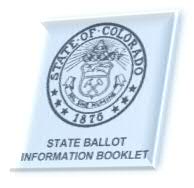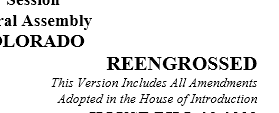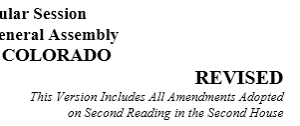By Kathy Zambrano
As the General Assembly moves toward the end of the regular legislative session, you may hear the terms “10-day bill” and “30-day bill” bouncing around the capitol hallways. What’s the meaning of these terms? And why does the General Assembly care?
Section 11 of article IV of the state constitution specifies that every bill passed by the General Assembly must be presented to the Governor before it can become law. If the Governor approves of the bill, he or she signs it and returns it to the legislative house of origin with a letter detailing the date on and time at which he or she signed it. If the Governor vetoes a bill, it is returned to the house of origin along with an explanation of the Governor’s objections, which are then printed in the journal of the House of Representatives or the Senate, whichever is the house of origin.
 If there are 10 days or more left in the legislative session when the Governor receives the bill, the Governor must act within 10 days after receiving the bill or it becomes law without the Governor’s signature. If there are fewer than 10 days left in the session or the General Assembly has already adjourned when the Governor receives the bill, the Governor has 30 days after the date of adjournment in which to approve the bill, allow the bill to become law, or veto the bill and file it with the Secretary of State.
If there are 10 days or more left in the legislative session when the Governor receives the bill, the Governor must act within 10 days after receiving the bill or it becomes law without the Governor’s signature. If there are fewer than 10 days left in the session or the General Assembly has already adjourned when the Governor receives the bill, the Governor has 30 days after the date of adjournment in which to approve the bill, allow the bill to become law, or veto the bill and file it with the Secretary of State.
If the General Assembly is still in session when the Governor vetoes a bill, the bill is calendared for “consideration of Governor’s veto” in the house of origin. Two-thirds of the members in both the House of Representatives and the Senate must vote affirmatively in order to override the veto.
So, a 10-day bill is a bill that the Governor must act on before the end of the legislative session. And, if the Governor vetoes a 10-day bill, the General Assembly may override the veto. With a 30-day bill, the Governor can wait until after the session is over to act on the bill. If the Governor decides to veto a 30-day bill, the General Assembly cannot override the veto.
To comply with the constitution, the House of Representatives, the Senate, and the Governor’s office enter into a formal memorandum of understanding regarding the details for delivering and returning bills, computing the ten-day and thirty-day periods for action by the Governor, and calculating the date when bills become law without the Governor’s signature.
Delivery and return of bills. The House, the Senate, and the Governor’s office agree to maintain regular weekday business hours of 8:00 a.m. to 5:00 p.m. During these hours, staff must be available to accept any documents, bills, or other communications from the Governor or the House or Senate. The parties agree to provide advance notice of any unusual circumstances relating to the delivery or return of bills. The delivery or return of bills is typically made within the regular business hours of the office unless other special arrangements are agreed to in advance.
When the Governor signs or vetoes a bill or allows a bill to become law without his or her signature, the Governor’s office delivers a letter from the Governor to the house of origin as soon as possible on the same day the bill is signed or vetoed or allowed to become law or, if the bill is signed or vetoed after business hours, the Governor’s office will deliver the letter the next morning that the house of origin is in session.
Computing 10-day and 30-day periods. In counting the 10-day period for action on a bill, the day that delivery is actually made is not counted. For example, if a bill is delivered to the Governor on a Monday, the first day of the 10-day clock for the Governor’s action is Tuesday. Since Saturdays, Sundays, and holidays are considered legislative days, they are counted in calculating the 10-day period.
10-day clock for the Governor’s action is Tuesday. Since Saturdays, Sundays, and holidays are considered legislative days, they are counted in calculating the 10-day period.
However, if the 10th day falls on a Saturday, Sunday, or holiday, the day on which the bill must be returned to the General Assembly is extended to the next day that is not a Saturday, Sunday, or holiday. For example, if the House or Senate delivered a bill on Wednesday, February 11, 2015, the 10th day would fall on Saturday, February 21, 2015. The Governor need not return the bill on Saturday or Sunday because the 10th day would be extended to Monday, February 23, 2015. If the Governor did not sign or veto the bill, it would become law at 12:01 a.m. on Tuesday, February 24, 2015. Similarly, if the House or Senate delivers a bill on a Wednesday and the 10th day is extended from Saturday to a Monday, but the Monday is also a holiday, the return date will be further extended to Tuesday.
This seems pretty straight forward, but if the General Assembly or the house to which a bill is to be returned is in session and conducting business on a Saturday, Sunday, or holiday, and the 10th day falls on that day (for example, President’s Day), then the Governor must return the bill on that day. For example, if the Senate delivers a bill on Wednesday, March 4, 2015, the 10th day is Saturday, March 14, 2015. If the House was adjourned for the weekend but the Senate was in session and conducting business on Saturday, March 14, 2015, the Senate bill must be returned by that date. If a bill is delivered on Wednesday, February 4, 2015, the 10th day is Saturday, February 14, 2015. The 10th day would therefore extend to Monday, February 16, 2015. While February 16, 2015, is a holiday (Presidents’ Day), if the General Assembly or the house to which a bill is to be returned is in session on the Monday holiday, then the Governor must return the bill by that date.
If the Governor does not sign or veto a bill but allows it to become law without his or her signature, it becomes law at 12:01 a.m. on the day following the end of the 10-day period. For example, a bill delivered to the Governor on Monday, February 2, 2015, would have to be acted on and returned to the house of introduction by the 10th day following delivery, Thursday, February 12, 2015. If no action is taken, it would become law without the Governor’s signature on the 11th day following delivery, Friday, February 13, 2015, at 12:01 a.m. A bill delivered to the Governor on Tuesday, February 3, 2015, would become law without the Governor’s signature on Saturday, February 14, 2015, at 12:01 a.m.
If the General Assembly prevents the return of a bill during the 10-day period by adjourning sine die, the Governor has an additional 30 consecutive days after adjournment within which he or she may sign or veto a bill  and file it with his or her objections with the office of the Secretary of State. The Governor must also act within this 30-day period on all bills enacted during the session and delivered after adjournment. If the Governor neither signs nor vetoes a bill but files it with the Secretary of State within the 30-day period, then it becomes law without the Governor’s signature. The 30-day period begins to run on the day following the day that the General Assembly adjourns sine die. The same rules apply in counting the 30-day period as apply in counting the 10-day period. For example, if the House or Senate delivers a bill to the Governor on Monday, April 27, 2015, the Governor may elect to take no action before adjournment and have an additional 30 days to act. The 10th day is Thursday, May 7, 2015. If no action is taken before the expiration of the 30-day period on Friday, June 5, 2015, the bill will become law on Saturday, June 6, 2015, at 12:01 a.m.
and file it with his or her objections with the office of the Secretary of State. The Governor must also act within this 30-day period on all bills enacted during the session and delivered after adjournment. If the Governor neither signs nor vetoes a bill but files it with the Secretary of State within the 30-day period, then it becomes law without the Governor’s signature. The 30-day period begins to run on the day following the day that the General Assembly adjourns sine die. The same rules apply in counting the 30-day period as apply in counting the 10-day period. For example, if the House or Senate delivers a bill to the Governor on Monday, April 27, 2015, the Governor may elect to take no action before adjournment and have an additional 30 days to act. The 10th day is Thursday, May 7, 2015. If no action is taken before the expiration of the 30-day period on Friday, June 5, 2015, the bill will become law on Saturday, June 6, 2015, at 12:01 a.m.
Important dates to know in April:
- For purposes of the 2015 Legislative Session, the 10-day clock expires April 24, 2015, assuming that neither house of the General Assembly works the weekend of April 25 and 26.
- All bills delivered to the Governor beginning Monday, April 27, 2015, are considered 30-day bills since the General Assembly must adjourn sine die, Wednesday, May 6, and the 10-day clock will expire Thursday, May 7.



















